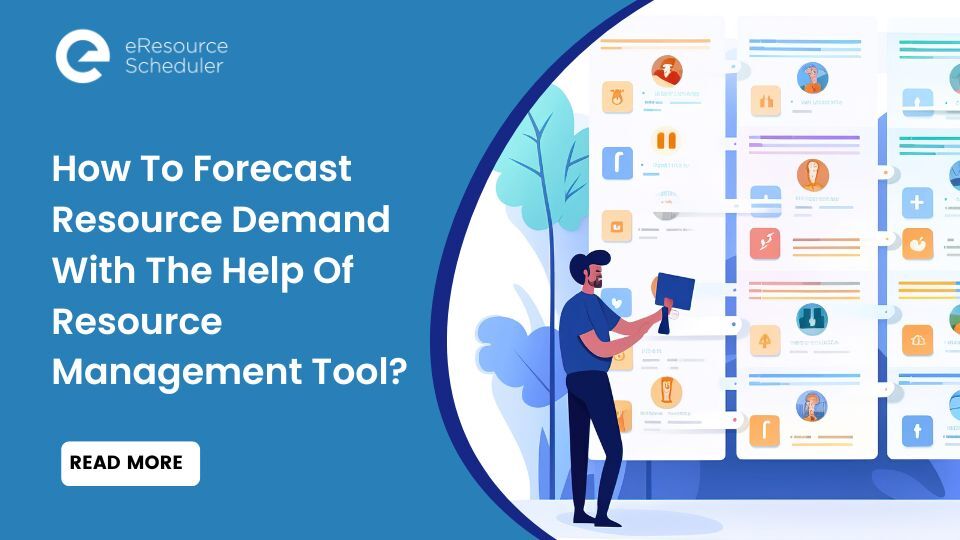
Nowadays, organizations grapple with an ever-pressing challenge: accurately forecasting and managing resource demand. It is a conundrum that can lead to a cascade of issues - overallocation, underutilization, and resource shortages - each with the potential to disrupt project timelines, strain budgets, and impact the bottom line. Traditional resource management methods have proven inadequate in the face of the constant flux of projects, tasks, and personnel. This often leaves organizations confused and struggling to keep up with resource demands.
However, a beacon of hope shines brightly on the horizon: resource management tool.These solutions stand ready to revolutionize the way organizations anticipate and allocate resources. By harnessing the power of data analytics, machine learning, and real-time tracking, these tools promise to empower businesses to accurately forecast resource needs, optimize workforce allocation, and ensure that every project runs seamlessly. In this simple guide, we will unveil the art of forecasting resource demand with the assistance of a resource management tool.
Resource demand is the heartbeat of successful project management. It is the pulse that determines whether projects thrive or stumble. Understanding resource demand is about knowing precisely what and how many resources are needed to meet project requirements. It is the route map that guides allocation decisions, ensuring teams have the right skills and tools at the right time. Without this insight, projects risk delays, cost overruns, and frustration.
Mastering resource demand is not an option but a necessity for organizations aiming to stay agile and competitive.
No, these two concepts differ significantly in the realm of resource management. Resource capacity refers to the maximum potential that a resource can provide for a particular task or project. It reflects the upper limit of what a resource can deliver. In contrast, resource demand focuses on the actual need for resources to complete specific tasks or projects within an organization. It quantifies the requirements necessary to fulfill operational or project-related functions.
The crucial distinction lies in their nature and purpose. Capacity represents what a resource can potentially offer, while demand outlines the real necessities to achieve specific goals. Effective resource management requires a harmonious alignment of resource capacity with resource demand. By understanding this, you can ensure that your organization has sufficient resources available precisely when and where they are needed.
Now that we have clarified the distinction between these two ideas. Let's refocus on resource demand forecasting and examine the consequences when organizations neglect it.
Effective resource demand forecasting is not just a matter of convenience; it is often the difference between success and stumbling in business. Without it, organizations are exposed to a host of challenges that can have far-reaching consequences:
Alright! Can HR team members or project managers manually perform resource demand forecasting? The answer is no, and this is due to several significant limitations.
Manually predicting and planning resource demand forecasting is not simple. Several factors contribute to this complexity. First, the volume of data involved in modern organizations is vast, making it challenging to analyze and interpret accurately without automated assistance. Second, manual methods are prone to human error, which can result in inaccurate forecasts, leading to overallocation or underutilization of resources.
Third, the dynamic nature of business operations and market conditions requires real-time data analysis, which is practically impossible to achieve manually. Finally, manual forecasting lacks the scalability and efficiency that automated resource management tools provide, making it an inadequate choice for today's fast-paced and data-intensive business environment.
So, what is the alternative plan for achieving perfect demand planning? Let's investigate that here.
To overcome these challenges, organizations are increasingly turning to this tool. They harness the power of data analytics and automation to provide accurate insights into resource demand, ensuring resources are allocated efficiently, budgets are optimized, and projects are executed on time.
In the following sections, we will delve deeper into how employee management tools are transforming the landscape of resource demand forecasting and allocation.
What exactly are they, and why are they the go-to solution for modern organizations? Let’s check.
Resource Management Tool is a specialized software or platform designed to help organizations plan, allocate, and optimize their resources effectively. These tools can handle a variety of resources, from human capital to physical assets and even budgets.
Imagine having a crystal ball for your organization, one that can predict when and where you will need resources, allowing you to stay ahead of the curve. That is what employee management tools offer - a glimpse into the future of your resource needs.
Now, you might be wondering and asking yourself, "Why should my organization bother with these tools?" Well, the benefits are nothing short of game-changing:
Alright, now that we have the tool in our hands. Next, we want to understand how it works and how we can use it, correct? Please read the following to find out.
Let's roll up our sleeves and dive into some practical strategies to really get a grip on resource demand.
Start by looking at your organization's workload. Break down the tasks that make up each project and figure out how many people, with their unique skills, you need to get them done.
Ask yourself what your employees are up to on a typical workday. What does their to-do list look like? How are they using their skills? This detective work helps you understand who's doing what and if they are putting their talents to good use.
Also, take a closer look at your project lineup. What level of skills and experience do they require from your team? And, the big one - do your current employees have what it takes to meet everyone's expectations?
These questions are your treasure map to resource utilization. Armed with this knowledge, you can fine-tune your resource allocation strategy and keep your projects cruising smoothly.
This image provides an insight into how resource utilization is depicted in the tool.
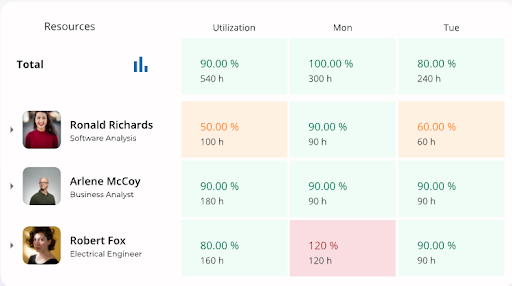
Reports from resource management tools serve as a powerful idea for management, simplifying the interpretation of data and facilitating well-informed decision-making.
It is not enough to know how efficiently your current resources are working; you also need to have your finger on the pulse of what lies ahead. Regularly engaging with stakeholders within your organization can provide invaluable insights.
Start by having casual conversations with decision-makers to uncover their future plans, especially regarding growth and client acquisition. Find out what they anticipate in terms of resource needs down the road. This information becomes the cornerstone of your resource demand forecasting.
When it comes to resource demand planning, scenario planning emerges as a valuable tool. It is like playing out different scenes in a movie before the cameras roll - it helps you anticipate the twists and turns.
Here is how it works: Take the insights you have gathered from stakeholder discussions and craft hypothetical scenarios. These scenarios allow you to gauge how increased or decreased workloads might impact your existing resources.
Picture this: You are assembling an engine, and each screw represents a role in your project. This is where placeholders come into play. Before you dive into the project, identify the roles you will need to make it happen. It is akin to creating a staffing blueprint, showing you who, when, and for how long.
One more thing is important. That is, checking the availability of your potential team members. Take a dip into your resource inventory to ensure everyone is accessible when needed. Budgets matter too. Scrutinize the project budget and resource costs. This way, you can determine if any resource reallocation is necessary to ensure it aligns with the project's financial boundaries.
By using placeholders strategically, you can gain clarity on the roles and resources in demand and ensure a seamless fit between your project's needs and your resource capabilities.
Leveraging advanced data analysis techniques, these reports provide insights into historical resource usage patterns, project lifecycles, and external factors that influence resource needs.
By harnessing the predictive capabilities of data analytics, organizations can forecast resource demand with greater accuracy. It enables proactive resource allocation, ensuring that the right resources are available at the right time to meet project requirements. Additionally, data analytics reports can identify trends and potential resource bottlenecks.
In resource management tools, reports can be presented in various formats, including hours, percentages (%), days, and FTE (full-time equivalent), as needed. Graphical representations enhance the accessibility and swift comprehension of data.
Here is what the graph representation looks like.
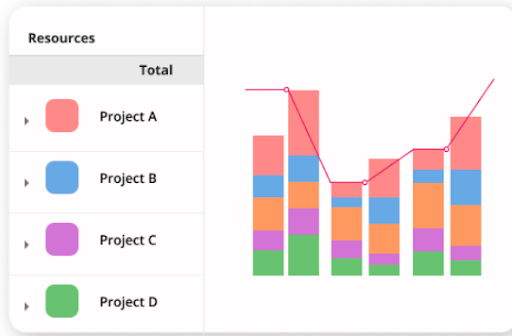
Financial reports offered by tools leverage rates and scheduling data to precisely forecast costs, revenue, and profits across various levels, such as resources, projects, clients, and more. Please check the image for more clarification.
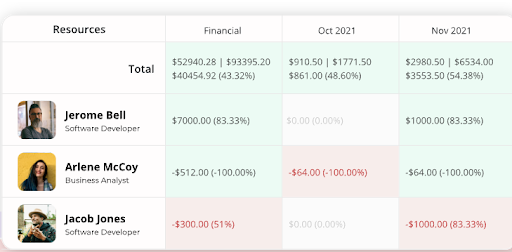
All right, these points have shed light on understanding resource demand. Now, let's explore some crucial tips for resource capacity planning. These insights will guide you in achieving an equilibrium between labor demand and staff capacity, all while aligning with your business objectives.
Resource capacity planning, the art of balancing resource demand with staff capacity, is a critical element in achieving operational efficiency. Here, we dive deeper into this dynamic process, unraveling key strategies that can make a profound difference in your resource management game.
Before rushing to hire full-time resources, take a step back. Why? Because, more often than not, the demand is ephemeral. Seasonal ebbs and flows, market trends, and project timelines all play a role.
So, what's the smart play here? Consider embracing flexibility. When the demand is temporary, don't tie yourself down with full-time hires. Part-time roles or contractors can be your dynamic duo in these scenarios. They swoop in when needed without creating a permanent commitment. This approach saves costs and ensures that your workforce aligns with the ever-changing tides of demand.
Is your resource demand a recurring phenomenon? Does it spike predictably at certain times of the year? If so, here is a pro tip. Build and nurture a roster of trusted contractors. Repeated collaborations with the same contractors simplify your life in several ways. First, you dodge the time-consuming task of scouting for new talent every time demand surges. Second, the onboarding process becomes a breeze as these seasoned contractors are already familiar with your operations. It is like having the best auto part that seamlessly integrates into your projects whenever the need arises.
Your resource demand data is not just a crystal ball for predicting future needs; it is a powerful tool for retaining top talent. If the data reveals that a particular individual is in high demand within your organization, take proactive steps to keep them on board.
Consider sweetening the deal by offering salaries that surpass industry standards. Provide perks that resonate with them, such as flexible work arrangements or opportunities for professional development. In essence, use your resource demand findings not just to plan for the future but also to nurture and retain the valuable assets you already have.
Resource capacity planning is not a one-size-fits-all endeavor. By understanding comthe beats of your resource demand and employing these strategic tactics, you not only optimize your workforce but also fortify your organization against the unpredictable tides of business.
Now, at last, we can grasp the significant value a demand planning tool holds for your business.
Let's check how the right software, such as eResource Scheduler, can be a game-changer in your resource management strategy.
Resource demand planning software is your trusty sidekick when it comes to resource planning and forecasting. It transforms what used to be a daunting task into a breeze. No more relying on gut feelings or guesswork; it is all about data-driven decision-making. With eResource Scheduler, you are equipped to make strate|gic resource allocation choices based on real-time data and insights.
Imagine having a bird's-eye view of everyone's schedule and workload. This is where the eResource Scheduler truly shines. It provides a holistic perspective, showing you precisely what each team member is working on. This invaluable feature prevents the dreaded scenario of overbooking employees and eliminates resource clashes. It is like having a traffic controller to ensure smooth resource flow across your projects.
This is how the tool displays the specifics of each employee.
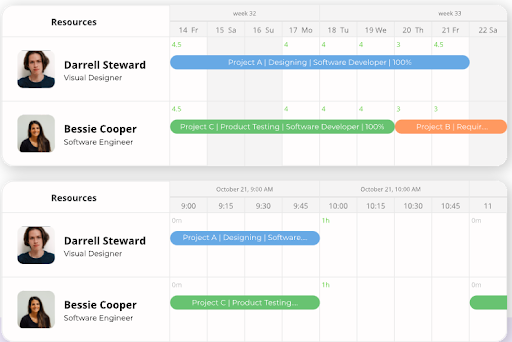
Resource allocation is not a one-size-fits-all game. It requires finesse, like selecting the right tool for a specific job. eResource Scheduler simplifies this process by offering a comprehensive employee inventory. Need a seasoned pro for that new project? No problem. With this software, you can effortlessly identify the perfect match based on an employee's experience and skill set.
Curious about how it works? Please check the image. This tool showcases crucial details such as roles, skills, qualifications, certificates, and more. Thus, it simplifies the process of swiftly identifying resources and projects through robust filtering options.
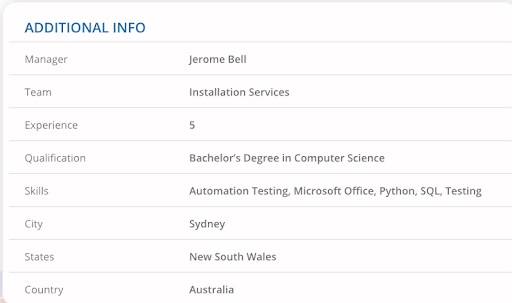
Sometimes, project dynamics change and a resource that seemed like a perfect fit may no longer align with the project's needs. eResource Scheduler has your back here too. You can reference its extensive database when it is time to reshuffle your resources. Whether it is finding a better-suited team member or adjusting schedules for a well-deserved break, this software streamlines resource reallocation, ensuring that your projects remain on track.
eResource Scheduler is not just a tool. It empowers you to make informed decisions, prevent resource conflicts, and optimize your workforce. So, whether you are planning a project, assigning resources, or adapting to changing circumstances, having the right software at your side is like having a dependable co-pilot on a journey toward resource management excellence.
Yes, resource management tools present a transformative solution for organizations facing resource demand forecasting challenges. Now we know why we need it. Precise forecasting is pivotal in ensuring effective project management, effectively averting overallocation, underutilization, and budgetary overruns.
These tools not only empower organizations to make data-backed decisions but also enhance the optimization of workforce allocation while proactively addressing upcoming resource needs. By offering a comprehensive overview of schedules and skills, they facilitate precise resource matching. Moreover, they efficiently streamline resource reallocation in response to shifting project dynamics.
In an ever-evolving landscape, these tools act as guiding compasses, leading organizations toward resource management excellence and maintaining their competitive edge.
Also read:
Plan Smarter. Schedule Faster.
Join thousands already using eResource Scheduler to align teams, time, and tasks seamlessly.